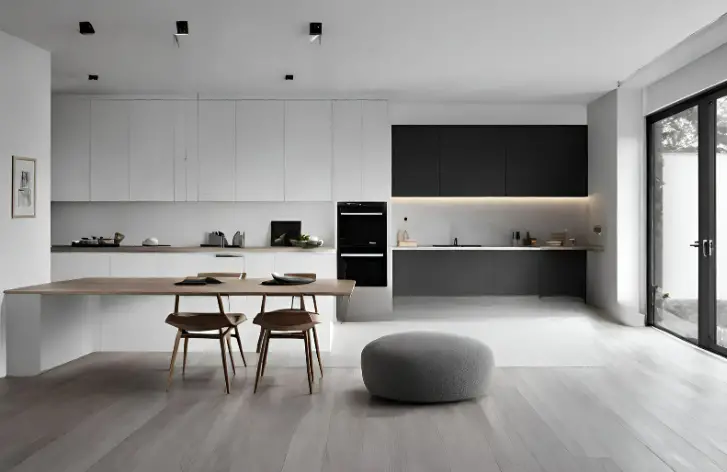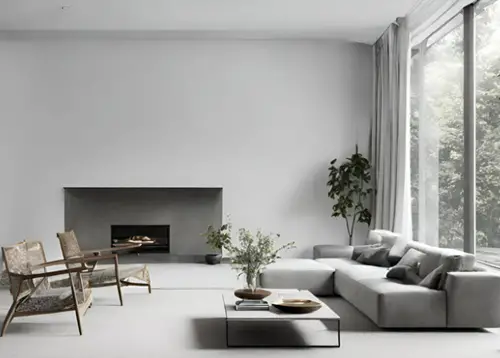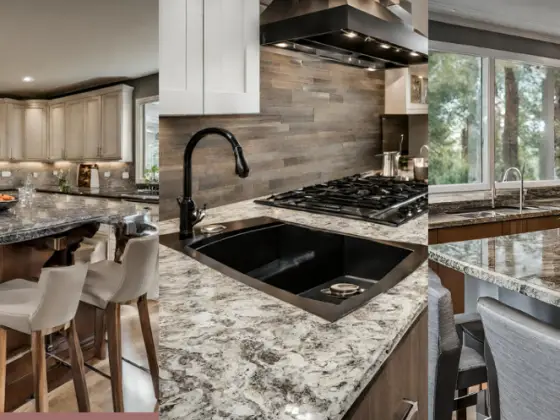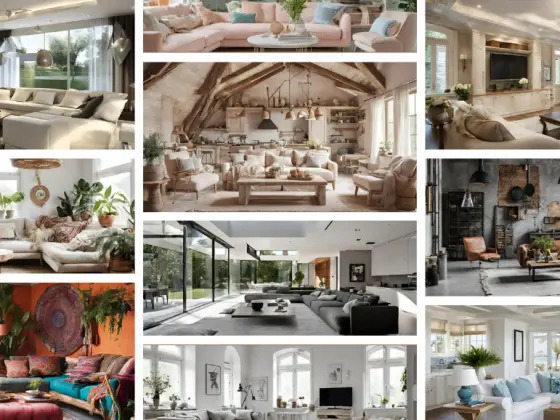
Minimalistic home design, characterized by simplicity, functionality, and the absence of clutter, is a concept that’s gaining significant traction in contemporary interior decor. This design approach allows you to create a space that is not only aesthetically pleasing, but also tranquil and highly efficient. In this comprehensive guide, we’ll delve into the multifaceted world of minimalism in home design, covering everything from the fundamentals to expert tips and advanced strategies.
Easy Tips for Minimalist Home Design
Minimalistic home design is more than just a trendy aesthetic; it’s a lifestyle choice that offers a myriad of advantages. It’s about stripping away the excess and embracing a sense of calm in your living space. By adopting minimalism, you can enhance your overall well-being and create a more sustainable and organized home environment.
Assessing Your Space
Before embarking on your minimalistic journey, take time to evaluate your current home design. Identify areas where clutter accumulates and assess the overall layout. Understanding your personal needs and preferences is pivotal to this process.

Decluttering and Organizing
The Art of Decluttering
Minimalism hinges on decluttering your living space. Ruthlessly assess your possessions, identifying items that no longer serve a purpose. Ditch those outdated magazines and broken appliances. Clinging to unused items clutters your mind and your home.
Sorting and Simplifying Possessions
Simplify your life by keeping only the items that bring you joy or serve a functional purpose. Organize your belongings into categories and establish designated storage areas for each. This minimizes chaos and enhances accessibility.
Minimalist Storage Solutions
Choose furniture with built-in storage and employ concealed storage solutions, like under-bed drawers or wall-mounted shelves. Make use of multifunctional furniture pieces, such as ottomans with hidden storage compartments, to maximize your space.
Color Palette and Textures
Choosing a Minimalistic Color Scheme
Minimalism often gravitates toward neutral color palettes. White, beige, gray, and black serve as ideal base colors, creating a canvas for other elements to shine.
The Role of Neutrals
Neutrals are versatile, providing a serene backdrop that allows key decor elements to pop. Use them on walls, furniture, and larger pieces.
Incorporating Textures for Depth
To avoid a monotonous appearance, introduce textures through fabrics and materials. Think of a rough-hewn wooden coffee table against a sleek, white wall.
Furniture Selection
Minimalistic Furniture Design
Select furniture pieces with clean lines and simple designs. Mid-century modern, Scandinavian, and Japanese styles often exemplify minimalism.
Multi-functional Furniture Pieces
Choose furniture that serves more than one purpose. A sofa that transforms into a bed or a dining table with hidden storage can free up significant space.
Open and Airy Furniture Arrangements
Arrange furniture to create an open and inviting ambiance. Leaving some space between furniture items fosters a sense of airiness and promotes ease of movement.
Wall Decor and Art
Selecting Minimalist Wall Art
Opt for wall art that follows the ‘less is more’ philosophy. Single, impactful pieces, like a large abstract painting or a carefully chosen photograph, can make a strong statement.
Incorporating Negative Space
Leave some wall space blank. Negative space is a fundamental aspect of minimalism, allowing the eye to rest and the mind to breathe.
The Power of Simplicity in Art
Simple, uncluttered art pieces evoke tranquility. Minimalist sculptures and paintings often convey profound emotions through their simplicity.
Lighting
Natural Light in Minimalistic Design
Maximize natural light by using sheer curtains or blinds that allow daylight to flood your space. Sunlight accentuates the clean lines and unadorned surfaces of minimalistic design.
Minimalist Lighting Fixtures
Opt for lighting fixtures that are themselves works of art. Pendant lights with clean, geometric lines or sleek, modern floor lamps can serve as functional decor pieces.
Creating Ambiance with Light
Dimmable lighting can help you set the desired mood. Soft, warm light is perfect for creating a cozy atmosphere.
Embracing Minimalist Patterns
Geometric Patterns
If you introduce patterns, opt for simple, geometric designs. Stripes, grids, and chevrons can add visual interest without overwhelming the space.
Stripes and Solids
Incorporate stripes or solids in your throw pillows, rugs, or upholstery. Keep it simple and avoid excessive pattern mixing.
Using Patterns Sparingly
Minimalist design relies on restraint. Use patterns sparingly to maintain a sense of calm and cohesiveness in your space.
Plants and Greenery
Minimalistic Plant Selection
Select a few carefully chosen plants that complement your overall design. Succulents and air plants are popular choices for their low maintenance.
Potted Plants as Decor
Pot your plants in simple, unobtrusive containers. The greenery itself should take center stage.
Balancing Nature with Design
Plants can add a touch of nature to your minimalist space, providing a refreshing contrast to man-made elements.
Digital Declutter
Minimalism in Digital Spaces
Extend minimalism to your digital life by decluttering your devices. Delete unused apps and organize your files.
Organizing Digital Files
Organize your digital files into well-labeled folders. This digital minimalism leads to increased efficiency and peace of mind.
Simplifying Digital Gadgets
Do away with redundant gadgets and cables. Invest in multi-functional tech products to reduce clutter and enhance functionality.
Functional Minimalism
Purposeful Room Layouts
Design your room layouts with purpose. Each piece of furniture should serve a specific function, eliminating the need for unnecessary items.
Streamlining Daily Routines
Incorporate minimalism into your daily routines. Simplify your morning and evening rituals, allowing for a more relaxed start and end to your day.
Minimalist Kitchen and Bathroom Design
Apply minimalism to your kitchen and bathroom. Keep only the essential utensils and toiletries, ensuring everything has its designated place.
Sentimental Items
How to Incorporate Sentimental Items
Minimalism doesn’t mean discarding cherished possessions. Display sentimental items thoughtfully, allowing them to shine.
Creating a Minimalist Display
Group sentimental items together in an aesthetically pleasing display, such as a gallery wall or a dedicated shelf.
Letting Go with Grace
For items you’re not ready to part with, consider digitalizing or taking photographs to preserve the memory while reducing physical clutter.
Minimalism in Different Rooms
Minimalism is adaptable and can be applied to various rooms in your home:
Living Room: A minimalistic living room can exude elegance and tranquility, with streamlined furniture and uncluttered surfaces.
Bedroom: A minimalist bedroom promotes rest and relaxation. Keep your sleeping space free of distractions.
Kitchen: Minimalist kitchens are functional and efficient, with well-organized cabinets and countertops.
Bathroom: In a minimalist bathroom, simplify your toiletries and choose clean, modern fixtures.
Home Office: A minimalist home office encourages focus and productivity. Keep your workspace tidy and well-organized.
Minimalist DIY Projects
Upcycling and Repurposing
Get creative by upcycling and repurposing old furniture and decor items, giving them a new lease on life.
Building Minimalist Furniture
Create custom minimalist furniture pieces tailored to your space and design preferences.
Custom Storage Solutions
Design and build storage solutions that meet your specific needs while adhering to minimalist principles.
The KonMari Method
Introduction to Marie Kondo’s Approach
Marie Kondo’s KonMari method emphasizes the importance of only keeping items that spark joy.
Applying the KonMari Method
Follow the KonMari method by decluttering by category, not by location, and by thanking items for their service before letting them go.
Maintaining a Minimalistic Space
To sustain a minimalist space, regularly review your belongings and ensure they align with your current lifestyle and values.
Sustainable Minimalism
Minimalism and Eco-Friendly Choices
Minimalism aligns with sustainability by encouraging a reduced ecological footprint. Choose eco-friendly materials and products.
Reducing Waste in a Minimalist Home
Minimalism naturally leads to reduced waste as you avoid buying unnecessary items and become more mindful of consumption.
Thrift Shopping and Minimalism
Thrift stores can be goldmines for minimalist decor. Embrace second-hand shopping to reduce waste and save money.
Minimalism and Feng Shui
Balancing Minimalism with Energy Flow
Integrate Feng Shui principles with minimalism to ensure energy flows harmoniously through your space.
Incorporating Feng Shui Principles
Incorporate elements like the Bagua map and the five elements into your minimalist design for balance and harmony.
Harmony and Minimalist Design
Minimalism and Feng Shui can coexist to create an environment that is both visually pleasing and energetically balanced.
Minimalism for Small Spaces
Maximizing Space Efficiency
In small spaces, minimalism is key to making the most of every square inch.
Compact and Multifunctional Furniture
Choose compact, multi-functional furniture that can adapt to your changing needs.
Minimalist Decor in Tiny Homes
Tiny homes are the epitome of minimalism. Embrace this lifestyle to make the most of limited space.
Budget-Friendly Minimalism
Achieving Minimalism on a Budget
You don’t need deep pockets to achieve a minimalist home. Focus on decluttering and smart, budget-conscious choices.
Affordable Decor Ideas
Look for affordable decor ideas, such as DIY projects or second-hand finds, to achieve a minimalist look without breaking the bank.
DIY Minimalism Projects
Explore DIY projects that transform your space into a minimalist haven while keeping costs down.
Maintaining a Minimalistic Home
Regular Decluttering
Make decluttering a routine. Regularly assess your belongings to ensure you maintain a clutter-free space.
Staying True to Minimalist Principles
Adhere to the principles of minimalism by keeping your space simple, functional, and unburdened by excess.
Adapting to Changing Needs
As your life evolves, so should your space. Adapt your minimalist design to accommodate changing needs and circumstances.
Seeking Inspiration
Minimalist Design Blogs and Books
Find inspiration from minimalist design blogs and books that showcase real-life examples of stunning minimalist homes.
Social Media and Minimalist Influencers
Follow minimalist influencers on social media platforms for a daily dose of minimalist inspiration and practical tips.
Visiting Minimalist Homes
Visit open houses or minimalist showrooms to see the principles of minimalism in action and gather ideas for your own space.
Overcoming Minimalism Challenges
Dealing with Resistance to Change
Resisting the urge to hoard can be challenging. Embrace the change gradually and focus on the benefits of minimalism.
Balancing Minimalism with Family Life
Maintaining a minimalist home with a family can be challenging. Involve your family in the process and set clear guidelines for the shared space.
Coping with Emotional Attachments
It can be emotionally difficult to let go of items with sentimental value. Learn to cherish the memories, not the physical objects.
Celebrating Minimalism Successes
The Joy of a Minimalistic Home
Celebrate the tranquility and ease that a minimalist home brings to your life.
Improved Wellbeing and Productivity
Recognize how minimalism enhances your overall well-being and boosts productivity by reducing distractions.
Hosting and Entertaining in a Minimalist Space
Minimalism doesn’t mean sacrificing hospitality. Create a welcoming space for guests that adheres to minimalist principles.
The Timeless Appeal of Minimalism
Minimalism’s Place in Design History
Minimalism has deep roots in art and design, dating back to the early 20th century.
Why Minimalism Endures
Minimalism endures because it transcends trends, offering a timeless aesthetic that adapts to evolving lifestyles and design preferences.
Minimalism as a Lifestyle
More than just a design trend, minimalism has become a lifestyle choice that encourages mindful consumption and simplicity.
Conclusion
Incorporating minimalistic design into your home is a transformative journey. By following these guidelines and embracing the principles of minimalism, you can create a living space that is not only visually pleasing but also conducive to a more balanced and fulfilling life. Minimalism is more than just an aesthetic; it’s a philosophy that can change the way you live and experience your home. Embrace the simplicity, let go of the excess, and watch your space and your life transform before your eyes.


